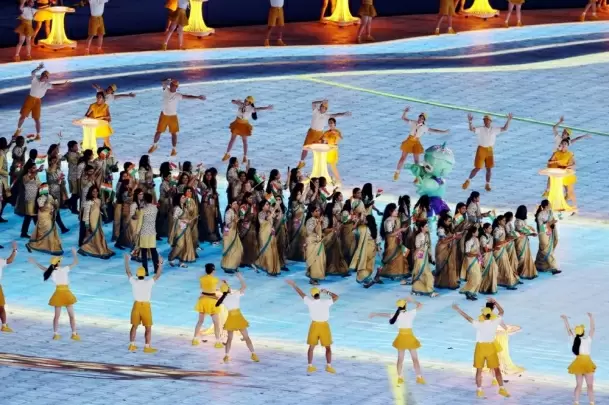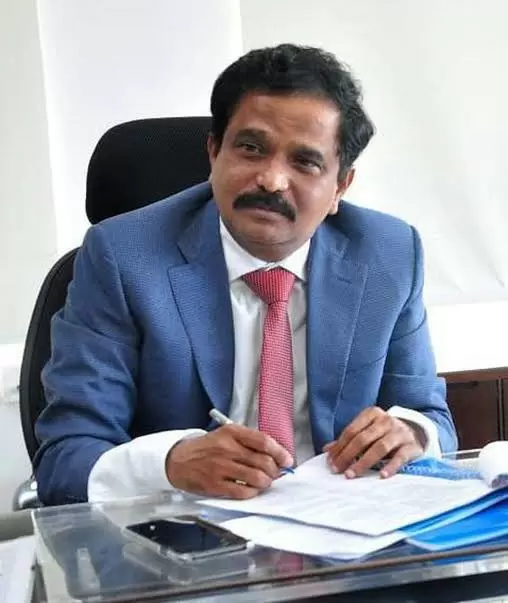Hangzhou's Powerful Fusion of Tech and Art Dazzles in Asian Games Opening
23-September-2023

With a theme based on water and tide, which are integral parts of city life here and promoting principles of simplicity, sustainability and cost-effectiveness, Hangzhou displayed before the guests from across the continent a spectacular opening ceremony that blended the power of technology and beauty of art and captured the distinctive Chinese cultural heritage.
The 90-minute-long programme captured China's cultural heritage and romantic imagery through the melding of its thousands-of-years-old civilisation and modern technology through stunning visuals, showcasing the dedicated efforts of the Chinese path to modernisation. It was a presentation that combined Eastern aesthetics and a viewpoint that can connect with a global audience and expresses the country's goodwill and aim of building a community with a shared future through an interplay of Chinese style and Asian appeal.
Water and tide were the abiding themes of the opening ceremony representing the surging tides of Asia, presenting different themes of "water" in its different forms -- mist, fog, West Lake, Qiantang Tidal Bores and the thousand-year-old Beijing-Hangzhou Grand Canal and the water conservation system of the Archeological ruins of Liangzhu City -- which are found in and around Hangzhou to bring out the connection between life and environment.
Water was also brought to life through the light of Liangzhu which was presented through the Liangzhu Jade Cong, a widely found artefact from the
archaeological ruins of the ancient Liangzhu City. For the opening ceremony, 19 pieces of jade cong were used to represent the number of editions of the Asian Games that have been held. By using these 19 water jade congs to create rhythmic beats, the ceremony once again brought out the water theme, as water becomes a means by which the Chinese people welcome incoming guests and create a warm atmosphere.
While expressing continuity, creativity and the inclusive nature of culture, the opening ceremony presented beautiful scenes that embody the uniquely Chinese approach to achieving modernisation by showing the happy lives of the Chinese people and showcasing China's innovative technologies through the integration of the virtual and real worlds, in today's era of Artificial Intelligence; and depicting the progress made by all Asian countries and regions, made possible by appreciating other cultures, and promoting the goal of shared prosperity.
Chinese President Xi Jinping declared the games open in the presence of Randhir Singh, acting president of the Olympic Council of Asia, President of the International Olympic Committee, Thomas Bach and other dignitaries.
Held at the Hangzhou Olympic Sports Centre Stadium, which the locals fondly refer to as the 'Big Lotus' as it is formed by 28 large and 27 smaller 'lotus
petals', the ceremony presented the distinctive motifs of the Chinese culture and life in Hangzhou, which has the undulating waters of the Qiantangjiang
River and the allure of Hangzhou silk as the backdrop.
With songs by some of the contemporary Chinese musicians and dance themed around culture and fitness, blue was the abiding colour and texture of the ceremony as it symbolises water, which the locals say is the heart and soul of Hangzhou.
The athletes' marchpast was led by the contingent of Bahrain with Bhutan and Brunei Darussalam following in that order.
The Indian Contingent resplended in their golden-tinged ceremonial livery walked out in the eighth position in a marchpast that took each contingent outside the stadium within minutes, unlike other previous ceremonies that allowed the athletes to stay in the stadium for the pledge and lighting of the cauldron and have fun listening to the music and dancing to the beat.
Though the contingent includes 921 members including 625 sportspersons 260 coaches and other support staff, only 200 of them participated in the ceremony as many sportspersons had events on Sunday.
The Indian contingent was led by flag-bearers Harmanpreet Singh, captain of the men's hockey team, and boxer Lovlina Borghain.
The Chinese contingent was the last to enter the stadium, which erupted in loud cheers as the huge contingent walked past the stands.
The athletes entered the stadium with the image of a circular fan on the ground, from which emerged visual elements and scenes of Southern China. On the hanging vertical backdrop, windows appeared with the plum blossom, orchid, bamboo and chrysanthemum, depicted with all their grace.
The ceremony started at 8 pm (local time) with the opening performance titled 'Water in Autumn Glow' which once again brought out into focus the ruins of Liangzhou City, which is a sacred site and a landmark in China's 5,000-year-old civilisation. In 2019, the Liangzhu Ruins were given the status of a UNESCO World Heritage.
September 23 signals the arrival of Autumn, which begins the season of harvest in China. The day is termed Qiufen (the Autumn Equinox), one of China's 24 Solar Terms. As it is a time to celebrate the harvest, the organising committee expressed the host city's heartfelt joy and open attitude to the guests from around the Continent.
As the national flag of China entered the stadium, hundreds of children from the city and country sang a chorus 'I love you, China, accompanied by a choir composed of ordinary residents and young students in the background.
Osmanthus is the city flower of Hangzhou and it made its appearance, with drums lighted in the form of Osmanthus, just before the athletes walked out as picking a bouquet of the flower in local parlance means winning a gold medal. With the striking of these ceremonial drums, the organisers sent out their best wishes to the Asian Games athletes, wishing them to win medals.
The Olympic Council of Asia (OCA) flag was brought into the stadium by some of China's sports legends like Xu Haifeng, Olympic champion shooter and China's first-ever Olympic gold medallist, Lou Yun, Olympic Champion gymnast who won the gold medal in the vault at two consecutive Olympic Games and champion diver Guo Jingjing, Winner of five consecutive championship titles at the FINA World Championship.
Chinese badminton player Zheng Siwei and table tennis player Sun Yingsha took the oath on behalf of all
athletes while Chinese athletics judge Yang Zhongmin and shooting jury Gao Jiaqi took the oath on behalf of the technical officials.
The ceremony concluded with digital fireworks which was a welcome departure from the traditional physical fireworks as they don't suit the principle of environmental protection being promoted by Hangzhou.- IANS
Khushbu Sundar’s X Account Hacked; Actress Seeks Urgent Help
ED Raids Bengaluru Dog Breeder Who Claimed to Own Rs 50 Crore Wolf-Dog
Raj Thackeray Slams Hindi Imposition in Maharashtra Schools, Warns of Statewide Protests
That Sassy Thing Raises ₹6 Crore to Disrupt Women’s Sexual Wellness Space
Suspended Kerala IAS Officer Prasanth Raises Promotion Demand During Hearing








